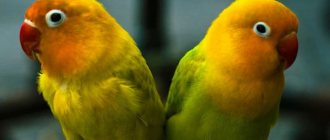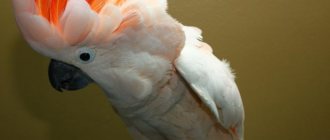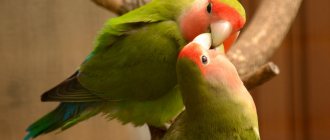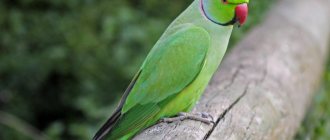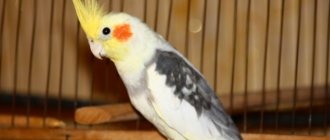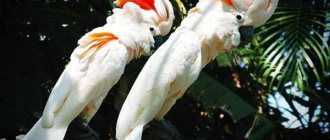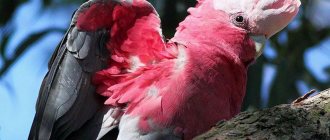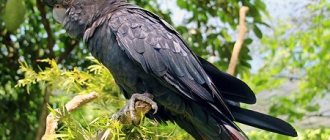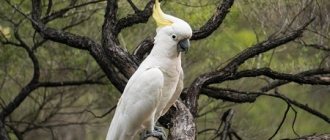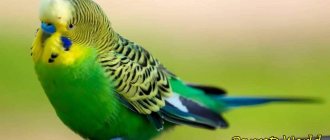- Wild animals
- >>
- Birds
The cockatoo parrot is an incredibly cute and intelligent parrot. It stands out among other parrot species with its crest and various shades of white, pink, gray and black. Domestic cockatoos are often called "Velcro" cockatoos due to their highly sociable nature and obsessive need to be close to people. Looking at its funny behavior, almost every bird lover is thinking about purchasing it.
Origin of the species and description
Photo: Cockatoo Parrot
The cockatoo was first identified as a subfamily Cacatuinae in the family Psittacidae by the English naturalist George Robert Gray in 1840, with Cacatua being the first type genera listed. Molecular studies show that the earliest known species were New Zealand parrots.
The word "cockatoo" dates back to the 17th century and comes from the Dutch kaktoe, which in turn comes from the Malay kakatua. Seventeenth-century variants included cocato, cocoon, and crocadore, while eighteenth-century varieties used cocato, socatura, and kakadu.
Fossil species of cockatoos are even rarer than parrots in general. Only one truly ancient fossil cockatoo is known: the Cacatua species, found in the early Miocene (16-23 million years ago). Although fragmentary, the remains are similar to the Slender-billed and Rosy Cockatoo. The influence of these fossils on the evolution and phylogeny of cockatoos is quite limited, although the fossil allows tentative dating of the divergence of subfamilies.
Video: Cockatoo parrot
Cockatoos belong to the same scientific order and family as other parrots (Psittaciformes and Psittacidae, respectively). There are a total of 21 species of cockatoos native to Oceania. They are endemic to Australia, including New Zealand and New Guinea, and are also found in Indonesia and the Solomon Islands.
Causes of premature death
At home, young cockatoos die mainly due to the carelessness of their owners. Keeping a bird, which is recognized as the most intelligent and inquisitive in the world, it is difficult to foresee all situations that are dangerous to its life.
According to experts, premature death of these parrots often occurs when:
- monotonous unbalanced nutritional diet (in the autumn-winter period, food should consist of 50% grain mixtures, and in the spring-summer period, it is advisable to reduce the amount of grains by 15%, replenishing the diet with succulent food (berries, fruits, vegetables, sprouted grains, leaves and herbs);
- food poisoning;
- various types of injuries;
- acute infectious and parasitic diseases, as well as untimely treatment (parrots often bleat with flu, colds, coccidiosis, helminthiasis, they have coughing, vomiting, wheezing, ticks);
- self-plucking;
- genetic defects.
Appearance and features
Photo: Cockatoo parrot bird
Cockatoos are medium to large parrots with a stocky build. Length varies from 30–60 cm, and weight ranges from 300–1,200 g. However, the cockatiel species is significantly smaller and slimmer than others, measuring 32 cm in length (including its long pointed tail feathers) and weighing 80 –100 g. The movable crest on the crown, which all cockatoos have, is impressive. It rises when the bird lands after flight or when excited.
Cockatoos share many features with other parrots, including a characteristic curved beak and foot shape with two middle toes facing forward and two outer toes backward. They are distinguished by the lack of bright blues and greens that can be seen in other parrots.
Cockatoos have short legs, strong claws, and a wriggling gait. They often use their strong beak as a third limb when climbing branches. Typically have long, broad wings, used in fast flight, at speeds of up to 70 km/h. Members of the genus Mourning Cockatoos and Great White Cockatoos have shorter, rounder wings and a more leisurely flight.
The plumage of cockatoos is less bright than that of other parrots. The predominant colors are black, gray and white. Many species have small areas of bright colors on their plumage: yellow, pink and red (on the crest or tail). Also for several species the priority color is pink. Some species have brightly colored areas around the eyes and face. The plumage of males and females is similar in most species. However, the female's plumage is duller than that of the male.
Cost of an exotic bird
Cockatoo is not cheap.
Its maintenance will cost even more. How much does a cockatoo cost in Russia and where can you buy these funny birds? Exotics are not uncommon these days; they are offered via the Internet by private breeders, pet stores, and nurseries. Purchasing a chick from a nursery or from a certified breeder provides certain guarantees of health, legal appearance in the country, and appropriate gender and age.
Such individuals have an international veterinary chip or a ring on their paw. The most budget option - a cockatiel - will cost 3,000-4,000 rubles, the cost of white cockatoos starts from 60,000 rubles, and yellow-crested ones - from 90,000 rubles. The price of rarer and larger birds reaches 500,000 rubles.
Where does the cockatoo parrot live?
Photo: Large cockatoo parrot
The distribution range of cockatoos is more limited than that of other parrot species. They are found only in Australia, Indonesia and the Philippines. Eleven of the 21 species can only be found in the Australian wild, while seven species are found only in Indonesia, the Philippine Islands and the Solomon Islands. No cockatoo species have been found on the island of Borneo, despite their presence on nearby Pacific islands, although fossil remains have been found in New Caledonia.
Three species are found in both New Guinea and Australia. Some species have a wide distribution, such as the pink cockatoo, which is found across much of the Australian mainland, while other species have tiny ranges confined to a small part of the continent, such as the black cockatoo of Western Australia or the small island group of Goffin's cockatoos (Tanimbar corella), which is only in the Tanimbar Islands. Some cockatoos have been introduced accidentally into areas outside their native range, such as New Zealand, Singapore and Palau, while two Australian species of Corella have been distributed to another part of the continent where they are not native.
Cockatoos live in subalpine forests and mangroves. The most common species are such as pink and cockatiel, which specialize in open areas and prefer grass seeds. They are highly mobile nomads. Flocks of these birds move across vast areas of the continent, finding and feeding on seeds. Drought may cause flocks from drier areas to move further into agricultural areas.
Other species, such as the glossy black cockatoo, are found in tropical rainforest scrub and even alpine forests. The Philippine cockatoo inhabits mangrove forests. Representatives of the genus living in the forest, as a rule, lead a sedentary life, since food supplies are stable and predictable. Some species have adapted well to altered human habitats and are found in agricultural areas and even in busy cities.
How many years have they lived at home?
These birds are always remembered for their artistry, emotionality and character. They can imitate absolutely all sounds and human speech, dance, sing, conduct a dialogue with the owner, amuse him, and sometimes peck painfully with their huge beak. Many people dream of having such a pet. And those who have already acquired it assure us of the great responsibility that rests with the owner for decades.
We recommend learning the most important things about keeping cockatoos at home.
With proper care and maintenance in captivity, parrots live longer than in their natural environment. Facts have gone down in history when some individuals lived to be 120 years or more. The oldest cockatoos in the world are the pink Kuki, a resident of the Brookfield Zoo (USA), who died in 1934 at the age of 83, and the great yellow-crested Koki, who died in 1943 at the age of 142. During his long life, Koki changed many owners. For more than half a century it was cared for at the London Zoo, and before that the bird grew up in a private home, where it was very loved.
The lifespan of domesticated individuals depends on many factors, as well as on the species to which the bird belongs:
| Cockatoo species | Features of behavior | Life expectancy at home |
| Black | They live more often in captivity than in zoos. It is difficult to keep them at home. Parrots have a bad character, are very freedom-loving, and quickly break cages, biting through metal mesh over 5 mm thick. In addition, in its natural environment, the black cockatoo feeds on Canary tree nuts, which are difficult for the breeder to find. The slightest mistakes in taming are fraught with aggression and resentment of the pet. | 40–50 years |
| Inca Cockatoo | They are distinguished by high intelligence. Rarely kept at home. They are not imported to Europe, and there are very few chicks bred by amateurs. Catching and selling these parrots is prohibited. In Australia itself they are kept only with the permission of the authorities. | 80–85 years |
| Moluccan | Differs in understanding. However, its ability to reproduce human speech is very limited. Can repeat only individual words (vocabulary up to 10 lexical units) and phrases. Imitates animal voices well. | 40–80 years |
| Nosy | Good at remembering tricks | over 70 years |
| Greater white-crested | It quickly learns human speech and perfectly imitates other sounds. If he doesn't get what he wants, he screams continuously. Can be aggressive. He is distinguished by gullibility, affection for people and excellent artistry. Can't stand boredom. | 50–70 years or more |
| Helmet-bearing | It is distinguished by its friendliness and is very socialized. | 65–70 years |
| Spectacled | It is easily tamed and quickly adapts to the conditions of the enclosure. | 50–60 years |
| Pink | When kept at home, it has excellent adaptation to new conditions, but is poorly trained in human speech and performing various tricks. | 50–60 years |
| Bare-Eyed | They are rarely kept in captivity. Only from chick age can they become tame and live for a long time at home. They do not have the ability to speak, but they can be taught to pronounce a few words. | up to 50 years |
| Solomonsky | They are kept extremely rarely at home due to the small population of these birds. They respond well to training. Able to imitate human speech, melodies and animal voices. | up to 55 years old |
| Philippine | They are not of great interest to breeders, since they do not have the ability to reproduce words and perform tricks. | more than 50 years |
| Greater yellow-crested | It is especially popular among breeders. It is distinguished by its affection for humans, does not speak, but often amuses its owner with various tricks, artistry, dancing and enviable intelligence. | up to 40 years old |
| Banks' mourning cockatoo | They are considered one of the rarest and most expensive domesticated birds. They quickly break the cells and heavily pollute the room (due to the abundant release of a white powdery substance for cleaning feathers, which can cause allergies). They require constant entertainment and special care. They tolerate boredom painfully, can pluck themselves, and often get sick. They are characterized by increased loudness and a tendency to chew all available objects. | up to 40 years old |
| Goffin's cockatoo | Well distributed as poultry. He quickly gets used to his owner and is loud (has an unpleasant hoarse voice). | up to 35 years old |
| Slender-billed | Rarely kept in captivity, does not tolerate boredom well. | 20–25 years |
| Corella | Popular with breeders. It quickly tames and gets used to the conditions of captivity. Can reproduce some words and melodies (often imitates street birds). | 10–15 years |
| Lesser yellow-crested | Common among breeders, it quickly gets used to new conditions and becomes attached to its owner. Doesn't talk, but does different tricks and dances. Very funny and smart. | 30–40 years |
What does a cockatoo parrot eat?
Photo: White cockatoo parrot
Cockatoos consume mainly plant foods. Seeds make up the majority of the diet of all species. Eolophus roseicapilla, Cacatua tenuirostris and some black cockatoos feed primarily on the ground in flocks. They prefer open areas with good visibility. Other species eat in trees. Western and long-legged cockatiels have long claws for digging up tubers and roots, and the pink cockatoo circles Rumex hypogaeus, trying to twist the above-ground parts of the plant and remove the underground parts.
Many species feed on seeds from the cones or nuts of plants such as eucalyptus, banksia, and hakea cape, which are native to the Australian landscape in arid regions. Their hard shell is inaccessible to many animal species. Therefore, mainly parrots and rodents feast on the fruits. Some nuts and fruits hang at the end of thin branches that cannot support the weight of a cockatoo, so the feathered southerner bends the branch towards itself and holds it with its foot.
While some cockatoos are generalists, eating a wide range of foods, others prefer a specific type of food. The glossy black cockatoo loves the cones of Allocasuarina trees, preferring one of its species, A. verticillata. It holds the seed cones with its foot and crushes them with its powerful beak before removing the seeds with its tongue.
Some species eat large quantities of insects, especially during the breeding season. Most of the yellow-tailed black cockatoo's diet consists of insects. Its beak is used to extract larvae from rotting wood. The amount of time a cockatoo has to spend foraging for food depends on the season.
During periods of abundance, they may only need a couple of hours a day to search for food, and spend the rest of the day squatting or preening in trees. But in winter they spend most of the day searching for food. Birds have increased nutritional needs during the breeding season. Cockatoos have a large crop, which allows them to store and digest food for some time.
Features of character and lifestyle
Photo: Yellow-crested cockatoo parrot
Cockatoos need daylight to find food. They are not early risers, but wait for the sun to warm their roosting areas before they go out in search of food. Many species are highly social and feed and travel in noisy flocks. Depending on the availability of food, flocks vary in size. During times of food abundance, flocks are small and number about a hundred birds, while during periods of drought or other disasters, flocks can swell to tens of thousands of birds.
The Kimberley has a flock of 32,000 cockatiels. Species that inhabit open areas form larger flocks than species in forested areas. Some species require roosting sites that are close to drinking areas. Other species travel long distances between roosting and feeding sites.
Cockatoos have characteristic bathing methods:
- hanging upside down in the rain;
- fly in the rain;
- tremble in the wet leaves of the trees.
This is the most fun species to keep at home. Cockatoos become very attached to the people who care for them. They are not very suitable for teaching spoken language, but they are very artistic and demonstrate ease in performing various tricks and commands. They can perform various funny movements. dissatisfaction is demonstrated through unpleasant screams. They are very vindictive towards the offender.
Social structure and reproduction
Photo: Cockatoo parrots
Cockatoos form monogamous bonds between pairs that can last for many years. Females breed for the first time between three and seven years of age, while males reach sexual maturity at an older age. Delayed sexual maturity, compared to other birds, allows for the development of skills in raising young animals. Little cockatoos stay with their parents for up to a year. many species consistently return to their nesting sites over many years.
Courtship is quite simple, especially for established couples. Like most parrots, cockatoos use hollow nests in holes in trees that they cannot make themselves. These depressions are caused by rotting or decaying wood, broken branches, fungi, or insects such as termites or even woodpeckers.
Hollows for nests are rare and become a source of competition, both with other representatives of the species and with other species and types of animals. Cockatoos choose cavities in trees that are only slightly larger than themselves, so species of different sizes nest in holes corresponding to their size.
If possible, cockatoos prefer to nest at a height of 7 or 8 meters, close to water and food. The nests are covered with sticks, wood chips and branches with leaves. The eggs are oval and white. Their size varies from 55 mm to 19 mm. Clutch size varies within a given family, from one to eight eggs. About 20% of eggs laid are infertile. Some species can lay a second clutch if the first one dies.
The chicks of all species are born covered with yellowish down, with the exception of the palm cockatoo, whose offspring are born naked. Incubation time depends on the size of the cockatoo: the smaller species incubate their eggs for about 20 days, while the black cockatoo incubates the eggs for up to 29 days. Some species can fly after 5 weeks, and large cockatoos can fly after 11 weeks. During this period, the chicks become feathered and gain 80–90% of the weight of adults.
Natural enemies of cockatoos
Photo: Cockatoo parrot bird
Eggs and chicks are vulnerable to many predators. Various species of lizards, including the monitor lizard, are able to climb trees and find them in hollows.
Other predators include:
- spotted tree owl on Rasa Island;
- amethyst python;
- shrike;
- rodents, including the white-footed rabbit rat in Cape York;
- Carpal Possum on Kangaroo Island.
Additionally, Galah (pink-gray) and small cockatiels competing for nesting sites with the glossy black cockatoo have been recorded where chicks of the latter species have been killed. Severe storms can also flood the holes, drowning the young, and termite activity can cause the nests to collapse internally. The peregrine falcon (duck hawk), Australian pygmy eagle and wedge-tailed eagle have been known to attack some species of cockatoos.
Like other parrots, cockatoos suffer from circovirus beak and feather infections (PBFD). The virus causes feather loss, beak curvature and reduces the bird's overall immunity. Particularly common in gray-crested cockatoos, small cockatiels and pink varieties. The infection has been found in 14 species of cockatoos.
Although it is unlikely that PBFD will have a significant impact on healthy bird populations in the wild. The virus may pose a risk to small populations exposed to infection. Like Amazon parrots and macaws, cockatoos often develop cloacal papillomas. The connection with malignancy is unknown, as is the cause of their appearance.
Buying a healthy pet
How long a cockatoo parrot lives in captivity is influenced by the health status of its parents. The correct diet of the female and the male during the mating season is very important - how healthy the offspring they will have depends on it. When planning to purchase a bird, choose carefully, because you will live with it for decades. Therefore, it is better if you know the rules for buying a healthy parrot, this will help you in choosing:
- purchase a cockatoo only from a trusted breeder or nursery - conditions have been created there for the normal upbringing of healthy offspring;
- It’s good if the bird has a ring on its paw - this is its kind of passport, which indicates the date and place of birth;
- for a bird from the nursery you will always be given documents where, in addition to the place and date of birth, the gender and health status will be indicated;
- buy a young parrot - they adapt and tame faster and easier;
- be sure to carry out an external examination of the pet: a healthy individual has beautiful smooth plumage without bald spots, clean eyes, ears, cere and cloaca without discharge, the surface of the beak without chips and growths, the bird is active and inquisitive.
When buying a cockatoo second-hand, you risk purchasing a sick or wild pet, which will subsequently cause many problems. Birds that were kept in cramped conditions, with poor nutrition, and lack of hygiene (this often happens with illegally exported parrots) experience extreme stress. Unfortunately, such cockatoos do not live long.
Of course, parrots sold in nurseries are much more expensive than wild, untamed ones or those offered by dubious sellers. However, without skimping on a healthy pet, you get an active bird, accustomed to humans, ready to communicate, learn and make friends. Such cockatoos become full-fledged members of the family, faithful companions for many years. In return for all of these invaluable qualities, you need to be prepared to provide your pet with quality care, meaningful companionship, and unconditional love.
Watch a video about the features of choosing and purchasing a healthy cockatoo parrot, as well as the intricacies of care and maintenance:
Population and species status
Photo: Pink cockatoo parrot
The main threats to the cockatoo population are habitat loss and fragmentation and wildlife trade. Maintaining the population at the proper level depends on the availability of nesting sites in the trees. In addition, many species have specific habitat requirements or live on small islands and have small ranges, making them vulnerable.
The Nature Conservancy, concerned about the decline in cockatoo populations, has hypothesized that suboptimal juvenile rates among the entire population may have occurred due to the loss of breeding grounds following inland clearing in the last century. This can lead to the aging of wild cockatoo flocks, where the majority are post-reproductive birds. This will lead to a rapid decline in numbers after the death of older birds.
Catching many species for sale is now prohibited, but trade continues illegally. The birds are placed in boxes or bamboo tubes and transported by boat from Indonesia and the Philippines. Not only are rare species smuggled out of Indonesia, but common cockatoos are also smuggled out of Australia. To calm the birds, they are covered in nylon stockings and packed in PVC pipes, which are then placed in unaccompanied baggage on international flights. The mortality rate during such “voyages” reaches 30%.
Recently, smugglers are increasingly exporting bird eggs, which are easier to hide during flights. The cockatoo trade is believed to be carried out by organized gangs who also trade Australian species for overseas species such as macaws.
Bird domestication
The first tame parrots appeared in Europe after the campaigns of Alexander the Great. The birds were popular and were kept in special cages made of ivory and silver.
In some countries, parrots were even considered sacred due to the fact that they could speak with a human voice.
Teachers were hired to teach strange birds how to talk. In those days, a parrot that knew a lot of words was valued more than a slave.
The fall of Rome had a negative impact on birds; nothing was heard about them for a long time. And only after the discovery of Australia and America and their subsequent colonization, bright birds appeared again in Europe. They came to Russia quite late: only in the 17th century.
